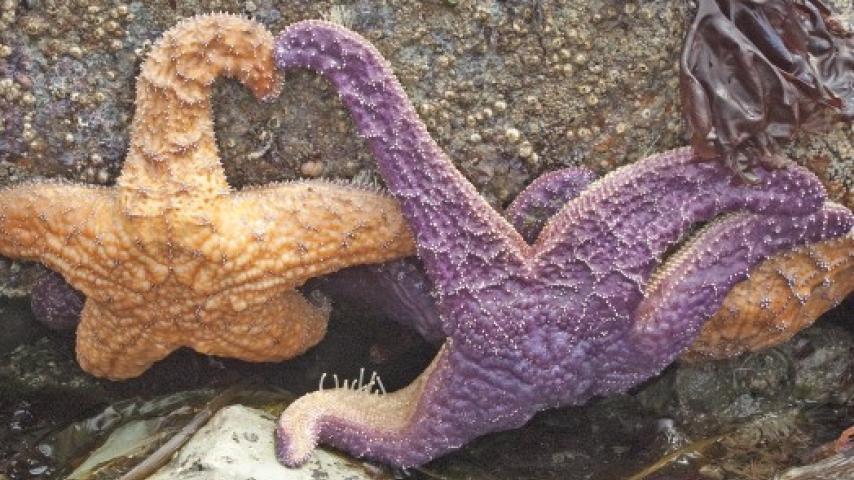Ochre Sea Star (Pisaster ochraceus)
Ochre Sea Stars are relatively large sea stars, with five arms and a rough surface, the short spines on the upper surface arranged in wavy patterns.

KINGDOM Animalia - PHYLUM Echinodermata - CLASS Asteroidea - ORDER Forcipulatida - FAMILY Asteriidae
Most of them are either orange (ochre) or purple, quite a dramatic difference, and there is still no good hypothesis to explain this color polymorphism. Purple types are more common in Puget Sound, orange types on the outer coast, but they are mixed in many areas.
Sea stars exhibit a form of radial symmetry in which each section of the body with its “arm” is like each other section. The mouth is located on the “bottom” or oral side, and the anus on the “top” or aboral side. They move by means of tube feet borne in ambulacral grooves all along the underside of each arm. Like other echinoderms, they have a series of tubes that make up a water-vascular system. The fluid within that system can be moved around, and the tube feet are extended and moved by hydraulic pressure from this system. Water can enter or leave the system through the madreporite, a small porous plate on the aboral side.
Ochre Sea Stars are the most commonly seen member of their group in many Pacific Northwest coastal areas. Virtual swarms of orange and/or purple starfish are exposed at especially low tides, often clustered under shady ledges or in crevices where they won’t get baked by the sun. From the numbers exposed as the tide goes out, they are clearly an intertidal animal.
In fact, they are one of the more important intertidal animals. The species has been called a “keystone species,” as its presence or absence significantly affects the entire community in the intertidal zone. Ochre Sea Stars are voracious predators on smaller animals, and among the very abundant animals on which they feed are mussels. Although their motion across the sea bottom is fairly slow, they do move about when searching for prey. A sea star envelops a mussel with its arms and, by applying many tube feet to each valve, is able to pull the shells slightly apart, no easy feat.
It then everts its stomach out through its mouth and inserts it into the shell, eventually digesting the mussel and absorbing its nutrients. By killing large numbers of mussels, Ochre Sea Stars determine to some extent their distribution. In fact, they can wipe them out completely from stretches of coast line. Mussels are superior competitors for space and may take over the rocky substrate over a large area, but the presence of the sea stars allows other animals to use the space that has been emptied of mussels.
In some areas, the sea stars are restricted to the lower intertidal, and above them is a whole band of species that can withstand greater desiccation and can escape Ochre Sea Star predation by this. But below that belt, a flourishing assemblage of marine species occurs, not crowded out by dense mussel beds.
The only predators of these starfish seem to be Sea Otters and gulls. Glaucous-winged Gulls stalk the intertidal and pick up small individuals (up to a radius of 6 cm) with great enthusiasm. Otters can crunch them up at any size.
Ochre Sea Stars can breed at the age of five, and they spawn during the summer. The sexes are separate, even though indistinguishable externally. A large female can produce 40 million tiny eggs, which are fertilized by sperm released by males. The tiny bilaterally symmetrical bipinnaria larvae float around in the plankton, then turn into biradially (actually pentaradially) symmetrical brachiolaria larvae in a few months, when they settle out of the plankton.


